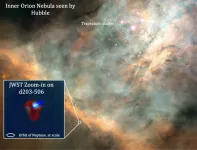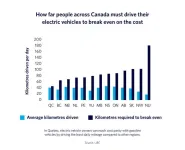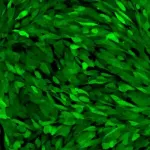(Press-News.org) Ultraviolet “winds” from nearby massive stars are stripping the gas from a young star’s protoplanetary disk, causing it to rapidly lose mass, according to a new study. It reports the first directly observed evidence of far-ultraviolet (FUV)-driven photoevaporation of a protoplanetary disk. The findings, which use observations from the James Web Space Telescope (JWST), provide new insights into the constraints of gas giant planet formation, including in our own Solar System. Young low-mass stars are often surrounded by relatively short-lived protoplanetary disks of dust and gas, which provide the raw materials from which planets form. As such, gas giant planet formation is limited by processes that remove mass from protoplanetary disks, such as photoevaporation. Photoevaporation occurs when the upper layers of protoplanetary disks are heated by x-ray or ultraviolet protons, which increases the gas temperature and causes it to escape from the system. Since most low-mass stars form in clusters also containing massive stars, protoplanetary disks are expected to be exposed to external radiation and experience ultraviolet-driven photoevaporation. Theoretical models predict that far-ultraviolet radiation produces photodissociation regions (PDRs) – areas where ultraviolet photons cast by nearby massive stars strongly influence gas chemistry on the surfaces of protoplanetary disks. However, direct observation of these processes has been elusive. Using near-infrared and submillimeter measurements from the JWST and the Atacama Large Millimeter Array, respectively, Olivier Berné and colleagues report observations of a FUV-irradiated protoplanetary disk, d203-506, located inside the Orion Nebula. By modeling the kinematics and excitation of the emission lines detected within the PDR, Berné et al. found that d203-506 is losing mass at a high rate due to FUV-driven heating and ionization. According to the findings, the rate at which this mass is being lost from d203-506 indicates that the gas could be removed from the disk within a million years, suppressing the ability for gas giants to form within the system. “Dynamical and compositional studies of the Solar System indicate that it formed in a stellar cluster that contained one or more massive stars, and so it might have been affected by FUV radiation,” Berné et al. write.
END
Ultraviolet “winds” erode a young star’s protoplanetary disk in Orion Nebula
2024-02-29
ELSE PRESS RELEASES FROM THIS DATE:
Pelagic fish more impacted by human pressures and protections than benthic species
2024-02-29
Pelagic fish – species that occupy the water column of the open ocean, neither near the bottom nor near the shore – are more impacted by both human pressure and protection than bottom-dwelling benthic species, researchers report. The findings highlight the need for increased marine protection in remote pelagic locations. Body size is a universal biological property that influences a range of ecological processes in marine ecosystems. Measuring body-size-structured variation can be a useful framework for understanding and predicting the impacts of overfishing or the success ...
Climate change is altering the seasonal pattern of river flow globally
2024-02-29
Climate change is altering the seasonality of river flow, particularly at high northern latitudes, according to a new study. Patterns in river flow vary with the seasons – a cycle that plays a critical role in floods and droughts, water security, and the health of biodiversity and ecosystems worldwide. Although recent studies have shown that climate change has already altered river flow seasonality (RFS), much of the evidence is limited to local regions or fails to consider the impact of climate change explicitly, independent of other human impacts to river flow. Consequently, the impact of climate warming on RFS isn’t ...
Conventional supply-side energy policies overlook benefits of demand-side policy approaches
2024-02-29
Energy security is a top priority across all levels of society because a host of global disruptions threaten energy systems and the critical functions they support. Most often, policymakers rely on policies and measurement indicators focused on energy supply to enhance energy security while ignoring demand-side possibilities. However, in a Policy Forum, Nuno Bento and colleagues argue that energy security is not solely security of supply; this limited focus fails to capture the full spectrum of vulnerability to energy crises. “Energy security is more than security ...
Radiation from massive stars shapes planetary systems
2024-02-29
How do planetary systems such as the Solar System form? To find out, CNRS scientists taking part in an international research team1 studied a stellar nursery, the Orion Nebula, using the James Webb Space Telescope2. By observing a protoplanetary disc named d203-506, they have discovered the key role played by massive stars in the formation of such nascent planetary systems3.
These stars, which are around 10 times more massive, and more importantly 100,000 times more luminous than the Sun, expose any planets forming in such systems nearby to very intense ultraviolet radiation. Depending on the mass of the star at the centre of the planetary system, this radiation can either help planets to ...
Climate change disrupts seasonal flow of rivers
2024-02-29
Climate change is disrupting the seasonal flow of rivers in the far northern latitudes of America, Russia and Europe and is posing a threat to water security and ecosystems, according to research published today.
A team of scientists led by the University of Leeds analysed historical data from river gauging stations across the globe and found that 21% of them showed significant alterations in the seasonal rise and fall in water levels.
The study used data-based reconstructions and state-of-the-art simulations to show that river flow is now far less likely to vary with the seasons in latitudes ...
Researchers reveal mechanism of how the brain forms a map of the environment
2024-02-29
When you walk into your kitchen in the morning, you easily orient yourself. To make coffee, you approach a specific location. Maybe you step into the pantry to grab a quick breakfast and then head to your car to drive to your workplace.
How these apparently simple tasks happen is of major interest to neuroscientists at Baylor College of Medicine, Stanford University and collaborating institutions. Their work, published in the journal Science, has significantly improved our understanding of how this occurs by revealing a mechanism at the brain cell level that mediates how an animal moves about in the environment.
“It’s been known that animals and people can find their ...
Improving energy security with policies focused on demand-side solutions
2024-02-29
Governments typically rely on policies focused on energy supply to enhance energy security, ignoring demand-side options. Current indicators and indexes that measure energy security focus mostly on energy supply. This aligns with the International Energy Agency’s view, which defines energy security only in terms of security of supply. However, this approach does not fully capture the extent of vulnerability for states, businesses, and individuals during an energy crisis.
“Energy security assessments also need to reflect how vulnerable countries, firms, and households are to energy ...
Driving an electric car is cheaper in some parts of Canada than others
2024-02-29
Electric vehicles are a critical part of Canada’s climate strategy, but a new University of British Columbia study highlights how it’s cheaper in some regions than others to drive electric—making it more challenging for certain households to make the switch.
Location, location, location
The researchers analyzed how far people need to drive their electric car to break even on the cost, factoring in the impacts of tax rebates and tax rates, charging costs, typical distance households travel in a region, and electricity ...
Emergency atmospheric geoengineering wouldn’t save the oceans
2024-02-29
WASHINGTON — Climate change is heating the oceans, altering currents and circulation patterns responsible for regulating climate on a global scale. If temperatures dropped, some of that damage could theoretically be undone. But employing “emergency” atmospheric geoengineering later this century in the face of continuous high carbon emissions would not be able to reverse changes to ocean currents, a new study finds. This would critically curtail the intervention’s potential effectiveness ...
New model of key brain tumor feature could help scientists understand how to develop new treatments
2024-02-29
ANN ARBOR, Michigan — Researchers at the University of Michigan Health Rogel Cancer Center are exploiting a unique biological feature of glioblastoma to gain a better understanding of how this puzzling brain cancer develops and how to target new treatments against it.
The team, led by senior author Pedro Lowenstein, M.D., Ph.D., Richard Schneider Collegiate Professor of Neurosurgery at Michigan Medicine, had previously identified oncostreams as a key feature in glioblastoma development and in more aggressive disease. These highly active, elongated, spindle-like cells ...


